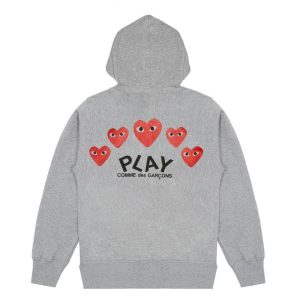Germany’s modern fashion landscape has transformed dramatically over the past decade, and Comme des Garçons stands at the center of this evolution. Known for challenging the expected, bending silhouettes, and rewriting the rules of luxury, Comme des Garçons has become a crucial force in shaping how German consumers engage with avant-garde fashion. As we explore its profound influence, we uncover how this Japanese powerhouse established a distinctive presence in Germany and reshaped a culture long associated with precision, minimalism, and functional aesthetics.
The Rise of Avant-Garde Fashion in Germany’s Urban Centers
Germany’s major hubs—Berlin, Hamburg, and Munich—have increasingly become spaces where experimental fashion thrives. Historically recognized for structured tailoring and industrial-inspired simplicity, German fashion culture has opened its doors to bold conceptualism, much of which has been shaped by the introduction and rising popularity of Comme des Garçons. German consumers, especially younger demographics, have grown to appreciate the brand’s radical expressions, embracing the tension between beauty and distortion that Rei Kawakubo masterfully creates.
As luxury boutiques across cities integrated Comme des Garçons into their curated selections, they introduced German shoppers to a world that extends far beyond conventional silhouettes. This shift helped expand Germany’s definition of luxury—from classic refinement to thought-provoking artistry.
Rei Kawakubo’s Philosophy and Its Reception in Germany
Rei Kawakubo’s revolutionary design philosophy—rooted in deconstruction, anti-fashion, and the exploration of imperfection—resonates deeply with Germany’s forward-thinking creative communities. Germany has long been a breeding ground for artistic rebellion, modernism, and the kind of intellectual exploration that mirrors Kawakubo’s design ethos.
Her pieces speak to German consumers who value fashion not merely as clothing, but as an exploration of identity, structure, and contradiction. The brand’s presence in Germany helped inspire local designers, encouraging them to challenge traditional structures and embrace conceptual risk-taking in their own work. In this way, Comme des Garçons contributed to positioning Germany as a European hub for progressive design.
Germany’s Retail Evolution and Comme des Garçons’ Influence
The demand for experimental fashion reshaped the country’s luxury retail scene. Concept stores such as those found in Berlin’s Mitte district and Munich’s high-luxury shopping neighborhoods leaned heavily into stocking brands like Comme des Garçons to attract a younger, more creatively inclined audience.
These stores recognized the magnetic draw of Kawakubo’s unconventional cuts and sculptural shapes. As a result, they designed retail environments that echoed Comme des Garçons’ immersive and sometimes surreal aesthetic. This shift had a cascading effect on Germany’s broader retail identity, positioning avant-garde fashion as not just a niche category, but a thriving and influential segment.
The Cultural Shift: From Tradition to Expression
German fashion enthusiasts increasingly viewed Comme des Garçons as more than a brand—it became a cultural symbol. The embrace of asymmetry, unconventional textures, and abstract silhouettes marked a notable departure from Germany’s historically traditional wardrobe norms.
This transition revealed a broader cultural movement within Germany: a desire to express individuality through fashion that breaks away from expectation. Comme des Garçons empowered consumers to communicate identity and emotion through clothing that defies symmetry and predictability. It became a badge of self-expression for artists, musicians, creators, and fashion-forward youth.
Comme des Garçons and Germany’s Expanding Creative Networks
With Germany becoming a global creative hub, particularly in Berlin, Comme des Garçons established deeper cultural ties within artistic networks that include design schools, independent creators, and fashion collectives. Students studying fashion in cities such as Berlin, Düsseldorf, and Hamburg found inspiration in Rei Kawakubo’s boundary-pushing design language.
This influence trickled into local fashion shows, student exhibitions, and editorial styling across German magazines. Comme des Garçons’ conceptual philosophy encouraged emerging designers to focus on narrative-driven collections, sculptural experimentation, and unconventional textile manipulation. The brand’s growing impact contributed to a new generation of German designers who prioritize conceptual originality over commercial conformity.
Germany’s Streetwear Renaissance and CDG’s Role
While the main Comme des Garçons line appeals to conceptual luxury consumers, the Comme des Garçons Play line ignited an entirely different fashion movement within Germany—streetwear with an artistic edge. The iconic heart logo became a recognizable emblem on German streets, particularly in cities with thriving youth cultures.
This widespread visibility introduced countless younger shoppers to the broader world of Comme des Garçons, ultimately guiding many toward Kawakubo’s more avant-garde collections as they matured. The brand’s ability to bridge both conceptual luxury and accessible streetwear strengthened its cultural presence and expanded its impact across multiple fashion segments.
Redefining Gender Expression in German Fashion
Comme des Garçons played a critical role in breaking down gender boundaries within Germany’s fashion scene. Germany’s progressive views on identity and self-expression found alignment with Kawakubo’s embrace of fluid form. Many collections defy traditional gender categorization, offering silhouettes that challenge the standard idea of menswear and womenswear.
This boundary-blurring approach resonated strongly in Germany—particularly in Berlin, where gender fluidity is celebrated. Comme des Garçons helped fuel conversations around identity in fashion and encouraged German consumers to explore clothing beyond the binary.
The Future of Comme des Garçons in Germany’s Fashion Landscape
As Germany continues evolving into a powerhouse of forward-thinking design, the influence of Comme des Garçons remains more prominent than ever. The brand’s philosophical contributions have reshaped the country’s understanding of experimental fashion, cultivated a generation of conceptual designers, and transformed luxury retail landscapes.
Moving forward, Comme des Garçons’ Comme Des Garcons Langarmshirt presence will likely deepen as German consumers continue to adopt and celebrate clothing that embodies emotion, distortion, imperfection, and individuality. It stands not only as a luxury label but as a symbol of progressive creativity woven into the fabric of Germany’s modern fashion identity.




